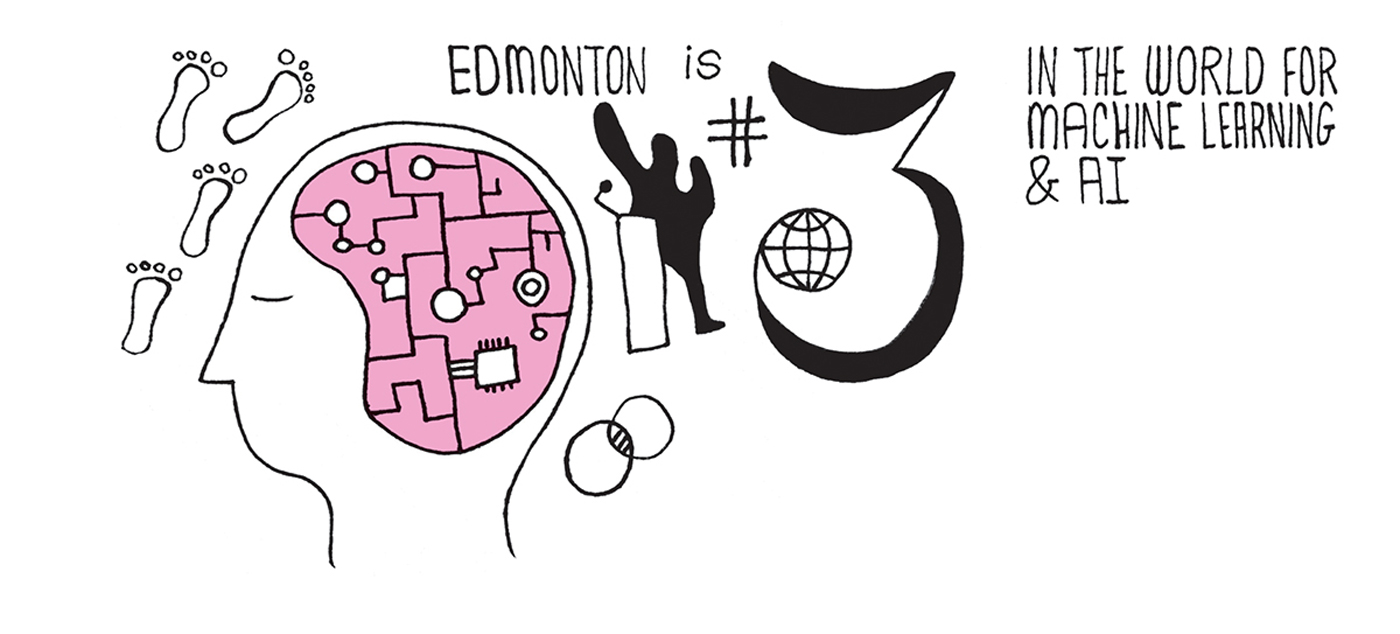
Early last year, Platform Calgary, Innovate Edmonton and Calgary Economic Development — organizations in Edmonton and Calgary that represent their respective tech sectors — were preparing to attend Collision, one of the largest technology conferences in North America, to promote their cities’ tech startups. After months of informal discussions, they decided to try something new: working together. As a team, they negotiated better exhibitor rates for both cities, secured booths next to each other and showcased more than 30 of Alberta’s emerging tech companies. No detail of their cooperation was too small; Edmonton brought the doughnuts, Calgary provided the coffee (and some local beer).
By all accounts, the cities generated more buzz working side by side, which never hurts when you’re competing for the attention of 25,000 attendees from around the world. “It is so hard to stand out as a country at these big trade shows and events, let alone as a city. We decided to work together to see what would happen,” says Terry Rock, president and CEO of Platform Calgary. “The feedback was, ‘Oh, Alberta’s serious,’ and people paid attention. We recognized that we can make way more noise when we show up together.”
Following their success at Collision, leaders at the two organizations — Cheryll Watson, formerly of Innovate Edmonton and Terry Rock from Platform Calgary — banded together to launch the Alberta Innovation Corridor (AIC) in June 2019. Calgary Economic Development, headed by Mary Moran, also came on board as a “funding founder.” Showing up together is what the cities’ new initiative is all about. The group’s activities are currently on hold due to the COVID-19 pandemic and the City of Edmonton’s decision to reorganize its organizational pyramid when it comes to supporting the innovation sector. But the joint pursuit plans to act as “an advocate for technology-enabled innovative companies,” committed to creating programs and services to help Alberta-based businesses succeed, while also attracting more talent, investment and companies to the province. Ultimately, the AIC is looking to drive economic prosperity for all Albertans. While the overarching goal is big, the initial steps have been small. So far, the founding leaders have posted a website, spoken publicly about the AIC and written the occasional op-ed. Each organization has committed money to cover nominal start-up costs and contributed staff hours for committee work tackling marketing communications, data collection and, eventually, to establish tangible programs. “We want to move from just showing up at events together to having programming on the ground supporting businesses but we’re not there yet,” says Rock.

When the organization springs back into action, the AIC’s main focus is spreading the word. And the word is Edmonton and Calgary are stronger together. “Edmonton is an academic and talent powerhouse, and we’re number three in the world for artificial intelligence and machine learning,” said Watson before she departed her post as the Economic Edmonton Development Corporation’s vice president in charge of Innovate Edmonton.
Watson’s departure was the first shoe to drop. In early May, city council voted unanimously to begin the process of replacing Innovate Edmonton with a new innovation entity, scheduled to be formed in the second half of 2020. The new body will no longer be under the EEDC umbrella. Instead, it will be run by an eight-person board, with members who have expertise in the innovation sector. The new entity will then formulate a plan which will be integrated into Edmonton’s wider economic development strategy, planned for the first quarter of 2021.
But, if the new Edmonton innovation entity won’t have a real plan in place till early 2021, what does that mean for the AIC? Does that mean the hold pattern will extend until next year?
“We wouldn’t want to wait a year to discuss that,” Edmonton Mayor Don Iveson said before council voted on the new innovation plan, but he added that talks will need to be held in private on how the corridor strategy will be revived, because so much of it depends on intergovernmental cooperation.
And there were fears within council that leaving the AIC on the back burner for too long could end up burning the city.
“I am anxious to have that conversation,” said Coun. Michael Walters. “From a strategic perspective, unless we keep our eye on that very carefully, it could be damaging to Edmonton, if we’re not completely engaged in (the AIC) in the interim.” Calgary is known for energy and financial services and its tech scene has been quietly growing in leaps and bounds, particularly in clean energy, agriculture and life sciences. In fact, according to a recent PwC report, Calgary’s tech sector ranked fifth in Canada for financial deal flow in 2019, behind Toronto, Montreal, Vancouver and Waterloo, when it secured 22 of the 37 deals that took place across all of Alberta, Saskatchewan and Manitoba.

To take Alberta’s tech industry to the next level, the AIC has a handful of near-term goals, including establishing a program to accelerate business development for artificial intelligence startups and advancing joint marketing activities to raise the province’s profile. “This is what we have to do right now because, globally, we’re sub-scale. We have to combine forces,” says Brad Zumwalt, a Calgary-based entrepreneur who, over the years, has grown and sold technology companies, including the stock photo businesses Eyewire and Veer, to the likes of Getty Images, Corbis and Adobe. He has always believed the cities need to cooperate and, in 2016, he co-founded Rainforest Alberta, a grassroots organization dedicated to improving Alberta’s innovation ecosystem. When asked how people will know if the AIC’s efforts are successful, Zumwalt says time will tell. “Our 10-year goal is to grow 1,000 great companies in Calgary and 1,000 great companies in Edmonton. So, it won’t be like, ‘Kumbaya, it’ll feel nice,’ if we do this. It has to deliver that number.”
The implied benefits of a thriving innovation corridor are massive — more jobs, greater investment, heightened ability to compete globally. But will it actually work?
Logistics pose the most obvious challenge to both cities working together. Google Maps says 299 kilometres separate Alberta’s major cities, but people from the AIC’s organizations have said they don’t mind driving, jumping on a Red Arrow bus or, when the occasion warrants, chartering buses to make the trip. They meet in person whenever is convenient and have weekly calls to drive the cause forward. If anything, the physical distance just means working harder to keep the other city in the loop. Watson said it’s easy to remember people you run into in the hallway or see out at a restaurant. Throw in a 300-km divide and cooperation gets trickier. “We are 100 per cent committed to this partnership, but things move so fast in the tech space,” Watson said before the Edmonton shuffle. “We’ll get halfway down a path on something and realize, ‘Whoa. Hey, did anyone call Calgary?’”

Making sure everyone is at the table is one thing. Making sure the right people are there is another. There are three government-funded organizations leading the AIC charge, but many others are advocating for the tech industry, at the same time. According to some entrepreneurs, it’s confusing and unnecessary. “There’s a myriad of organizations and no one knows what to make of all of them. Their wires are disconnected and there’s no cohesive purpose,” says Chris LaBossiere, the Edmonton-based co-founder and CEO of Yardstick Software Inc. He lists a handful of agencies working to advance the tech sector in the province’s capital alone: TEC Edmonton, Startup Edmonton, Edmonton Global, Western Economic Diversification Canada and Alberta Women Entrepreneurs, among others. “I don’t know if the Alberta Innovation Corridor is just the idea of two or three people or if this is the start of a consensus in terms of how we talk about this in Alberta. Colour me cynical or maybe a little bit suspicious of how successful it will be,” says LaBossiere.
Despite this cynicism, a central purpose does seem to be afoot. Edmonton’s new innovation authority is meant to be run by the people who best understand how the new economy works. The recruitment process for the board has already begun, and the city is willing to look not only at people in Edmonton’s tech sector, but expats who have moved to tech hotspots around the world. As administration reported to council, the new body would be “for the community, by the community” and would be more streamlined and nimble than Innovate Edmonton, which is scheduled to be shut down by autumn of this year. At the provincial level, Rock says Alberta Innovates, the organization that provides funding for innovation networks across the province, has encouraged Edmonton and Calgary to collaborate more in the future. And Rock says the AIC is up to the challenge – and will be transparent about its progress, if for no other reason than to keep the partnership’s efforts moving. As he says, “We want to be publicly accountable.”
Mary Moran, president and chief executive officer of Calgary Economic Development (CED), isn’t concerned about who leads and who follows, or even who’s involved in the AIC, as long as the work gets done. She’s excited about the opportunity to reposition the cities as an innovation hub and says the AIC is just one of many CED initiatives designed to create jobs in Calgary. To her, getting the word out to the rest of the country and beyond will be one of the AIC’s biggest challenges. “Toronto and Waterloo, and even Vancouver and Montreal, are well known for their innovation ecosystems,” she says. “We’re a late entrant into the technology world because the story of innovation in Alberta has been grossly under-told. I always jokingly say, ‘I can retire the day we get federal politicians standing up and talking about the Edmonton Calgary innovation corridor, as opposed to Toronto/Waterloo.”
If telling Alberta’s innovation story is one of the AIC’s biggest challenges — and opportunities — some may question who, exactly, is doing the telling. In the past, tech entrepreneurs have expressed concern over traditional businesspeople and long-term bureaucrats leading government-funded organizations, such as those involved with the AIC. If the organizations don’t understand the ins and outs of the fast-moving sector, how are they expected to advocate for its success?
“As far as I’m concerned, we’re the best at knowing how to sell our business,” says Daniel Riddell, chief technology officer at Kidoodle.TV, a Calgary company creating safe streaming services for children. Riddell himself is based in Edmonton and says the company has been grateful to receive funds from national and provincial entities, but their programs sometimes miss the mark. “For example, we might receive funding to go to a conference abroad, but we’re not able to receive more funding to give a presentation or be a sponsor to promote our business, which would make the biggest impact. The rules are so rigid, and they don’t see outside the box,” he says. “I do think there could be better knowledge amongst the staff of those organizations about opportunities like ours.”
Dr. Breanne Everett, president, CEO and co-founder of Orpyx Medical Technologies in Calgary, believes the disconnect stems from the fact that the tech sector is relatively new in Alberta. But she says there has been progress at organizations like Calgary Economic Development, where staff are getting up to speed on the city’s emerging life sciences sector. “There’s a lot of learning that has to be done by the people supporting the sector,” she says, “but I think they’re doing a good job of recognizing the opportunities here and trying to understand the lay of the land.” And though she isn’t sold on the AIC’s plan to market the cities as one hub, she is certain someone needs to fight for tech entrepreneurs.
In 2019, the United Conservative Party terminated two programs encouraging growth in the tech industry, one of which gave companies a tax rebate on research and development, and another that gave investors a 30 per cent tax credit for investing in small, technology-focused businesses. Everett says the “backwards” move delivered a blow to Alberta’s tech companies that was both absolute and relative. She says Alberta’s industry is now at a disadvantage, forced to compete with provinces that still have similar, if not better, programs in place. In this way, Everett is hopeful the AIC can make a difference. “Anytime you can get people within the province creating a louder voice to push back on policy changes that negatively affect a growing sector, that amplification is key,” she says. “For that reason, I think something like [the AIC] is excellent.”
Alex Hryciw was the director of strategy and government relations for Innovate Edmonton. She worked closely with Watson. She said the AIC’s members had been meeting with the Alberta government to lobby for new business-friendly initiatives, including a visa program for startups and a startup-in-residence program that would make it easier for small tech companies to land Alberta-based corporations and governments as their first customers. Collaborating on initiatives like these is just the beginning for the corridor. “Imagine how much more powerful the bids Edmonton and Calgary made for Amazon would have been had we pitched both cities’ strengths and the regions between them,” said Hryciw. “Long term, there are so many different spinoffs that could come out of the two huge municipalities working together.” And if one of those spinoffs happens to make travel between Edmonton and Calgary faster, that would be icing on the AIC’s cake (although it’s not officially tackling that cause, yet). “Wouldn’t it be great if we had high-speed rail between the cities?” says Rock. “It would not be a linear change in the amount of activity. It would be exponential.” As the AIC group strives to make Alberta a better place to do business, it’s keenly aware that people have to want to live here, too. Knowledge workers seek out cities that are livable and relocate accordingly. If Alberta wants to retain its own highly educated workforce and attract international talent, the AIC needs to start promoting its major cities, and fast. Malcolm Bruce, CEO of Edmonton Global, says when he polled 22 international site selectors (firms that help companies relocate to places around the globe), 82 per cent said they had never thought about the Edmonton Metropolitan Region. The rest said they did think about Edmonton. They thought of it as “cold, remote and disconnected.”
LaBossiere says the image problem is real. “In 15 years of trying to recruit executives, we’ve never had any one of them want to come here,” he says. “Partly because of that livability conversation, we eventually moved [one of our company’s] head offices to Ottawa before we sold it.” If the AIC can succeed in shifting the existing narrative, as well as promoting the Alberta story, Bruce says both municipal regions will reap the benefits. “It won’t always be symmetric, but the fact is we will win together.”
Earlier this year, the province scored a win when ESQ Business Services, a global software development company in the financial services sector headquartered in Silicon Valley, California, announced Calgary as the home of its new Canadian subsidiary, Cloudexa Technology. Bob Perreault, ESQ’s COO, says the company considered Vancouver, Montreal, Winnipeg, Toronto and Calgary before making its decision. Executives were looking for a “livable city” for their employees, one with a good work/life balance, an affordable cost of living, plenty of leisure activities and easy commuting. “Calgary’s livability is one of the best in the world,” says Perreault, “so that gave us a focal point.” The most important factor, he says, was how the City of Calgary and CED worked together to make ESQ’s process easier. “Everything we needed, from leases to attorneys to service providers, they had already done the research for us,” he says. “That allowed us to open our office six to 12 months sooner than we would have elsewhere.”
The AIC’s efforts didn’t play into ESQ’s decision-making process, but Perreault has seen the website and thinks it’s a fantastic idea. “If you want to diversify out of the oil and gas industry, as the province does, you have to find complementary opportunities for people who will be displaced out of that or who come in and do something different,” he says. Cloudexa is hiring locally and encouraging ESQ employees to move to Calgary, with plans to grow the office to approximately 50 to 75 people by its second year of business. As far as Perreault is concerned, Alberta’s innovation corridor currently extends “to north Calgary,” but that doesn’t mean he’s not rooting for the initiative. “If [the AIC] succeeds, then I have the opportunity to grow my business even more,” he says. “We’re starting with one city and once we make that successful, we’ll go from there.”
Though Edmonton wasn’t in the race to win Cloudexa’s business, Alberta’s major cities will surely be forced to compete in the months and years to come. And what will the AIC do then? The AIC is working on establishing some rules of engagement. “If we’re competing for something, we have to have a way of having that conversation that doesn’t sour everything,” says Rock. When it comes to the battle, he is confident everyone involved will remember what matters most. “Ultimately, we have to forget the notion that it’s about our organization or our city. It’s actually about creating jobs and helping founders get their tech companies going.”
On a Wednesday night in February, nearly 100 of said entrepreneurs gathered for a private event on the second floor of Trolley 5 Brewpub, a bar in the heart of Calgary’s Red Mile. Startup Calgary was hosting an event called Startup Drinks & Pitches. Founders, investors and supporters showed up to make connections, mingle and run their ideas past a room of like-minded people. Once everyone had settled in, organizers began pulling names out of a jar to determine the 10 people who’d get onstage and give their one-minute pitches. Signs next to the stage gave tips such as “Be concise, less is more,” and “Be enthusiastic.” (The first nugget of advice for the audience? “Be encouraging.”) The crowd listened intently to the ideas, among them an app to help consumers find the most affordable groceries and a widget to improve business communications. There was cheering. Conversation. Sharing. Though one table full of entrepreneurs had not yet heard about the AIC or its mission, it was clear that cooperation is a concept they understand well.
“If you’re in the tech sector, you’re probably trying to solve a problem. If you’re going to solve it for Calgary, why not solve it for Edmonton and Lethbridge and Red Deer and everyone else, as well?” said Tyler Doell, who was there to chat about Fundsustain Inc., an online business he’s developing to help charities and non-profits raise monthly donations. “It’s important to have that fluidity between our two major cities, to have that community and to share resources. Hockey differences aside, at heart we all have pride in being Albertan.”
Through a people-first approach, the A100 supports up-and-coming tech entrepreneurs to create their businesses. As entrepreneurs themselves, the A100 members use their knowledge and experience to give back to the tech community.
Working with local businesses, government and community partners, Calgary Economic Development’s goal is to make Calgary an attractive place for businesses. This not-for-profit corporation is funded by the City of Calgary, community partners and other forms of government through the Team Calgary program.
calgaryeconomicdevelopment.com
With eight locations globally, this program is helping support science- and technology-based companies all over the world. CDL-Rockies is based out of the Haskayne School of Business at the University of Calgary and specializes in energy and medical technologies, among other industries.
The vison of the team at Edmonton Global is to make the Edmonton Metropolitan Region a choice location for global investment. This regional organization works to attract investment and talent from around the world.
Working with the health innovation ecosystems in the Edmonton area, Health City wants to showcase Edmonton as a hub for health technology. The goal is to bring the world-class research and innovation that is happening in the health sector into commercialized products for the public.
This organization is being phased out, and is scheduled to cease operations this fall. It will be replaced by a new innovation authority.
A civic entity that operates on behalf of the City of Calgary to encourage innovation in the city. Platform supports startups and entrepreneurs and is in the process of launching the Platform Innovation Centre, which is scheduled to open in early 2021.
Rainforest is a movement created in 2016 by entrepreneurs in Calgary and Edmonton. The program cultivates an environment where innovation can thrive and other local entrepreneurs can meet to bounce ideas off one another.
In 2017, Startup Calgary became part of Calgary Economic Development and now works to create connections for startups and local businesses. Startup Calgary guides entrepreneurs.
With mentoring, coworking space and community events offered through Startup Edmonton, small businesses have the support they need. Tech-enabled products are the focus of this organization and it offers free memberships for students.
This business accelerator helps health-technology companies to grow and develop. A joint initiative between the University of Alberta and the Edmonton Economic Development Corporation, TEC Edmonton is made up of both entrepreneurs and researchers.
This is the federal government’s organization responsible for economic growth in Western Canada. It provides programs and services and supports legislation that allows businesses in Western Canada to apply for funding and other services.
This article appears in the June 2020 issue of Avenue Edmonton













